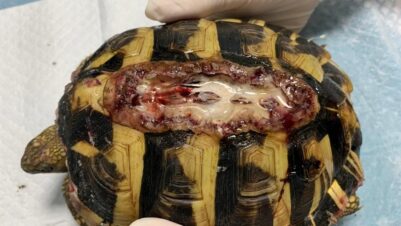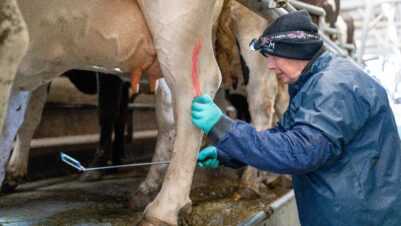Reptiles in captivity can carry a wide variety of diseases, both viral and otherwise. The traditional cautionary tale regarding pet reptiles of Salmonella, while fair, is also a gross simplification and must be put aside as the only likely consideration for a diseased reptile. In reptiles, it is generally accepted that relatively few viruses have been clearly proven as aetiological in nature, but rather that they have been found in sick reptiles. There are some, however, that have a pronounced clear impact on a reptile.
The prevalence of viral diseases in reptiles
Reptiles are classified within four orders: Crocodilia, Testudines (chelonians), Squamata (both lizards and snakes) and Rhynchocephalia (the tuatara). Due to their diversity, there are a range of potential viral diseases that a reptile can contract; however, it is also worth noting that often they follow certain “themes” for the order to which the animal belongs.
In the UK most exotic pets will be chelonians or squamates. Crocodilians require a dangerous wild animal licence and are not easily accessible, so therefore are less likely to be presented to a veterinary practice by members of the public. Tuatara are only found within New Zealand and their trade in captivity is limited to zoological collections and strictly regulated.
There are a range of potential viral diseases that a reptile can contract; however, it is also worth noting that often they follow certain ‘themes’ for the order to which the animal belongs
Lizards and snakes (squamates) have been diagnosed more commonly with adenoviruses or reoviruses. By comparison, herpesviruses are more common within chelonian species. However, both adenoviruses and herpesviruses have been confirmed as present for some time through histology, as they cause inclusion bodies within the infected individuals’ tissues. Ranaviruses have also been largely detected in chelonians and paramyxoviruses have particularly been seen within varied snake species (Marschang, 2011). This list is not exhaustive, and it is important to note that reclassification and confirmations are ongoing and can be limited geographically to certain species. However, with the wildlife and pet trade, certain viruses are becoming more prevalent globally; for example, the practice of farming snakes is linked to a global spread of inclusion body disease (IBD) within snakes (Wozniak et al., 2000).
| Did you know we offer CPD membership plans? Get access to thousands more articles, hundreds of short courses and easily fulfil your annual CPD requirements. Find out more here. |
Identifying and diagnosing viral diseases in reptiles
Adenoviruses

Adenoviruses have been reported within a wide variety of species across the orders of Testudines and Squamata (in both lizards and snakes) (Davison et al., 2003). The species particularly relevant to the private pet sector include royal pythons and bearded dragons (Figure 1).
Adenoviruses are transmitted through oral contamination from faeces. In the pet trade, bearded dragons are often kept within hatch groups which are only split up when purchased by a new owner. As such, the risk of viral spread from young is high, but within otherwise healthy adults, the case reports are lessened or potentially considered as “latent”.
Adenoviruses cause a variety of clinical signs; however, the disease itself largely impacts the gastrointestinal tract and hepatic system (Parkin et al., 2009). Commonly seen symptoms are often generalised and may include lethargy, weakness, anorexia and gastrointestinal signs; neurological issues may also be seen. Other signs may include a failure to “thrive”, whereby the individual doesn’t gain condition. The disease can result in death, which can be sudden. Adenoviruses have not been reported as zoonotic to people.
It is important to diagnose the virus correctly as the generalised signs can often be mistaken for other problems, such as coccidia burden or even nutritional issues (in fact, the animal could have all at once). Mortality rates in infected young dragons are high; however, with supportive fluid and feeding treatments, it is survivable. Isolation is always recommended, and there is no known cure or shedding limit.
Herpesviruses

Herpesviruses are reported within all orders of reptiles except crocodilians. The virus is seen most regularly in pet tortoises and secondly in lizards. Clinical signs differ depending on species; however, in tortoises, signs can include both generalised signs and specific issues, including a reluctance to use the mouth, ocular swelling, nasal discharge, lesions or respiratory symptoms (Figure 2) (Une et al., 2000).
As herpesviruses are highly transmissible and often fatal, their impact upon an individual is serious, and within larger collections, it can be devastating. Diagnosis is via PCR testing. Herpes in chelonians is not to be confused with the human disease (Origgi et al., 2004). The chelonian variant is chelonian-specific with no reported zoonoses. Isolation, supportive care and potential use of acyclovir have all been reported for treatment, with the outcome being dependent on diagnosis and treatment start time. There is no known cure, but with good husbandry and supportive care, patients can remain symptom-free (Winter et al., 2022).
Reptarenavirus

The main disease caused by reptarenavirus is inclusion body disease (IBD) of boid snakes. It is a severe, non-curable disease where euthanasia is recommended for both animal welfare and minimisation of transmission. Boas (Figure 3) are most often infected, and the virus can be present for years with limited clinical signs. Transmission is via bodily fluids, and either direct interaction or fomites are high-risk areas of transmission (Wozniak et al.,2000). Like other reptile diseases discussed, cleanliness is key as the disease can quickly spread throughout a collection with poor biosecurity measures.
Often the clinical signs of this condition worsen with immunosuppression or stress. Given that large quantities of boas are still imported, it is unsurprising that clinical signs worsen within a short space of time. Generalised symptoms are present; however, regurgitation, secondary bacterial infections, dysecdysis and seizures are all common. Stargazing is a common symptom in infected snakes, where they are unable to hold themselves correctly or balance. Pythons often present more acutely when compared to members of the boa family. As with herpesviruses, PCR provides a definitive diagnosis.
Summary
Thorough biosecurity is integral to the control of these diseases, alongside sourcing individual animals from reputable sources, screening measures and more widespread knowledge across all areas of the veterinary and pet trade industry
The international wildlife and pet trade is linked with the global prevalence of viral diseases, including in reptiles. Clinical signs of reptile viral diseases may appear generic across multiple causes; however, the potential impact is serious not only for the individual animal but also for both captive and wild populations. Thorough biosecurity is integral to the control of these diseases, alongside sourcing individual animals from reputable sources, screening measures and more widespread knowledge across all areas of the veterinary and pet trade industry.











